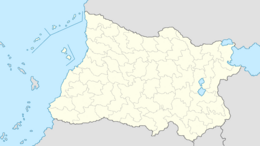Sukong: Difference between revisions
mNo edit summary |
mNo edit summary |
||
| Line 4: | Line 4: | ||
{{Infobox country | {{Infobox country | ||
|conventional_long_name = Federated Socialist States of Sukong | |conventional_long_name = Federated Socialist States of Sukong | ||
|native_name = 綠國聯赤邦 ([[Sukong language|Sukong]]) | |native_name = 綠國聯赤邦 ([[Sukong language|Sukong]])<br>Lòu Kkě Lìen Chǐeak Pàoung | ||
|common_name = Sukong | |common_name = Sukong | ||
|status = <!--Status of country, especially useful for micronations--> | |status = <!--Status of country, especially useful for micronations--> | ||
| Line 129: | Line 129: | ||
}} | }} | ||
'''Sukong'''({{wp|IPA}}:/ˈsʊ.kɒŋ/), officialy the '''Federated States of | '''Sukong'''({{wp|IPA}}:/ˈsʊ.kɒŋ/), officialy the '''Federated Socialist States of Sukong''' (Amilagran: 綠國 (Lòu Kkě) {{wp|IPA}}:/lou˧˩k:˧˩˦/, 綠國聯赤邦 (Lòu Kkě Lìen Chǐeak Pàoung) {{wp|IPA}}:/lou˧˩k:˧˩˦lien˧˩t͡ɕʰiøk̚˧˩˦pɒuŋ˧˩/) is a country in northwestern [[Olivacia]]. Sukong covers a land area of TBAkm<sup>2</sup> (297,329 sq mi), with a population of 310,341,837 inhabitants, ammounting to a population densitsy of 403 inhabitants per km<sup>2</sup> (1,043.8/sq mi), it is one of the most densely populated nations in [[Anteria]], and the largest {{wp|confucianism|confucianist}} majority country, with over [TBA]% of the population identifying as confucianist. The majority of the population (about 60%) live in the western part of the country, near the coast of the [[Sunadic ocean]]. | ||
Sukong is a {{wp|federal republic|federal}} {{wp|marxism-leninism|Marxist-Leninist}} {{wp|one-party state|one-party}} {{wp|parliamentary republic|parliamentary}} {{wp|socialist state|socialist republic}}, with an elected [[People's Federal Council|legislature]]. It has TBA states, of which all have their own legislature, leader, and constitution. There are three {{wp|unincorporated area|unincorporated territory}}, called [TBA], which doesn't have it's own constitution or leader. Sukong's capital, TBA, is the largest city in the country and among the largest in [[Olivacia]]. Sukong shares {{wp|border|land borders}} with [[Horokoshi]] in the south, and [[Zartona]] in the southeast, as well as a {{wp|maritime border}} with [[Riamo]] in the northwest. | Sukong is a {{wp|federal republic|federal}} {{wp|marxism-leninism|Marxist-Leninist}} {{wp|one-party state|one-party}} {{wp|parliamentary republic|parliamentary}} {{wp|socialist state|socialist republic}}, with an elected [[People's Federal Council|legislature]]. It has TBA states, of which all have their own legislature, leader, and constitution. There are three {{wp|unincorporated area|unincorporated territory}}, called [TBA], which doesn't have it's own constitution or leader. Sukong's capital, TBA, is the largest city in the country and among the largest in [[Olivacia]]. Sukong shares {{wp|border|land borders}} with [[Horokoshi]] in the south, and [[Zartona]] in the southeast, as well as a {{wp|maritime border}} with [[Riamo]] in the northwest. | ||
Revision as of 18:38, 12 February 2024
This article is incomplete because it is pending further input from participants, or it is a work-in-progress by one author. Please comment on this article's talk page to share your input, comments and questions. Note: To contribute to this article, you may need to seek help from the author(s) of this page. |
Federated Socialist States of Sukong 綠國聯赤邦 (Sukong) Lòu Kkě Lìen Chǐeak Pàoung | |
|---|---|
| Official languages | Sukong |
| Ethnic groups (2023) | TBA |
| Religion (2023) | TBA |
| Demonym(s) | Sukong |
| Government | Federal Marxist-Leninist one-party parliamentary socialist republic |
| Legislature | People's Federal Council |
| Area | |
• | 770,079 km2 (297,329 sq mi) (not ranked) |
| Population | |
• 2024 estimate | |
• 2023 census | 310,341,837 |
• Density | 403/km2 (1,043.8/sq mi) (not ranked) |
| GDP (PPP) | 2023 estimate |
• Total | |
• Per capita | |
| GDP (nominal) | 2023 estimate |
• Total | |
• Per capita | |
| Gini (2023) | 37.2 medium · not ranked |
| HDI (2023) | high · not ranked |
| Currency | Amilagran Lubang (Ł) (ALU) |
| Time zone | UTC+4, +5 |
| Date format | DD/MM/YYYY |
| Driving side | right |
| Internet TLD | .am |
Sukong(IPA:/ˈsʊ.kɒŋ/), officialy the Federated Socialist States of Sukong (Amilagran: 綠國 (Lòu Kkě) IPA:/lou˧˩k:˧˩˦/, 綠國聯赤邦 (Lòu Kkě Lìen Chǐeak Pàoung) IPA:/lou˧˩k:˧˩˦lien˧˩t͡ɕʰiøk̚˧˩˦pɒuŋ˧˩/) is a country in northwestern Olivacia. Sukong covers a land area of TBAkm2 (297,329 sq mi), with a population of 310,341,837 inhabitants, ammounting to a population densitsy of 403 inhabitants per km2 (1,043.8/sq mi), it is one of the most densely populated nations in Anteria, and the largest confucianist majority country, with over [TBA]% of the population identifying as confucianist. The majority of the population (about 60%) live in the western part of the country, near the coast of the Sunadic ocean.
Sukong is a federal Marxist-Leninist one-party parliamentary socialist republic, with an elected legislature. It has TBA states, of which all have their own legislature, leader, and constitution. There are three unincorporated territory, called [TBA], which doesn't have it's own constitution or leader. Sukong's capital, TBA, is the largest city in the country and among the largest in Olivacia. Sukong shares land borders with Horokoshi in the south, and Zartona in the southeast, as well as a maritime border with Riamo in the northwest.
Etymology
History
Geography
Climate
Biodiversity
Enviroment
Government and politics
Government
Administrative divisions
Largest populated areas
Judicial system and law enforcement
Human rights
Foreign relations
Military
Economy
Resources
Transport
Research
Tourism
Demographics
Population
Urbanisation
Migration
Religion
Spread of Christianity
Native religious beliefs
Health
Education
Languages
Culture
Cinema
Music
Literature
Architecture
Art
Cuisine
Sports
See also
Notes
External links


